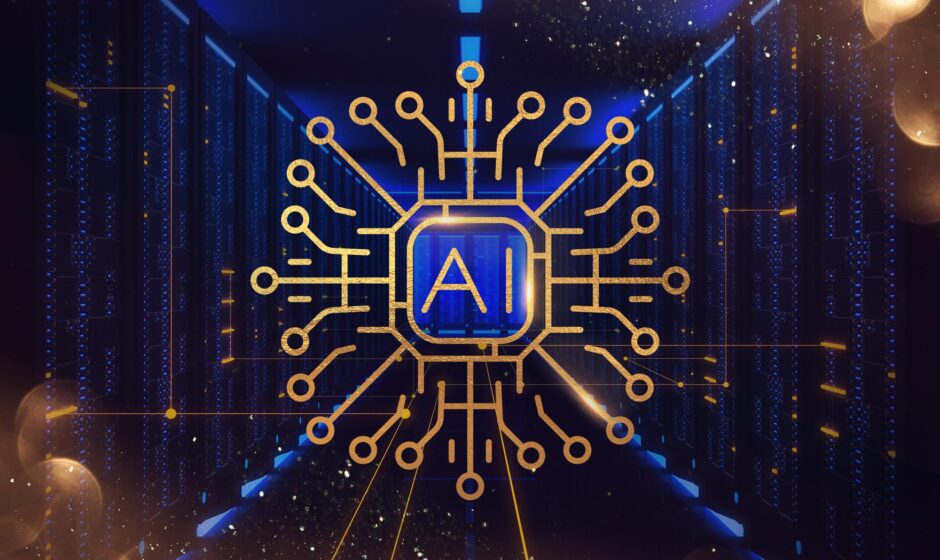In the hallowed halls of Hollywood, where dreams are spun and magic comes alive on the silver screen, a historic deal has sent shockwaves through the bustling city of dreams. At the intersection of art and technology, a monumental agreement has been forged, promising to revolutionize the film industry as we know it: an alliance between the renowned film studio, Silverlight Studios, and the enigmatic AI firm, NovaTek Industries.
The whispers that fill the air are laden with anticipation, brimming with speculation about the potential ramifications of this monumental partnership. But amidst the dazzle of red carpets and the glamour of award ceremonies, there are whispers of a darker side, lurking in the shadows of this unprecedented deal.
As the curtain rises on this captivating new chapter in Hollywood’s history, we must delve into the depths of this alliance, shining a light on the problems that lurk beneath the surface. Join us as we navigate the treacherous waters of artificial intelligence, where creative innovation meets moral quandaries, and the future of film hangs in the balance.
Lack of Diversity and Representation in Hollywood’s Historic AI Deal
In the midst of Hollywood’s groundbreaking AI deal, there are troubling storm clouds looming over Tinseltown. While the magnitude of this historic collaboration between artificial intelligence and the entertainment industry cannot be denied, it is imperative that we address the problematic lack of diversity and representation that continues to persist. As the curtain rises on this new era of technology-infused storytelling, we must confront the longstanding biases and inequalities that threaten to cast a shadow on Hollywood’s progress.
One of the primary concerns lies in the underrepresentation of marginalized communities, both in front of and behind the camera. A closer look at the partnership reveals a notable absence of diverse voices and perspectives, with the decision-making powers predominantly resting in the hands of a select few. This lack of inclusivity not only perpetuates a cycle of homogeneity in storytelling but also denies audiences the opportunity to see themselves reflected on screen.

Unveiling the Ethical Concerns of Hollywood’s AI Collaboration
As Hollywood embarks on an unprecedented collaboration with artificial intelligence (AI) technology, a host of ethical concerns loom large over this historic deal. While the prospect of leveraging AI to enhance storytelling and filmmaking holds undeniable allure, it is vital to acknowledge the potential pitfalls that may accompany such an ambitious partnership.
One of the primary concerns revolves around the erosion of creativity and human input. AI has the ability to analyze vast amounts of data and generate content, but can it truly replicate the nuanced emotions and depth of human storytelling? By relying too heavily on AI algorithms, there is a risk of losing the human touch that is essential for compelling narratives. Additionally, ethical dilemmas arise when AI is tasked with making creative decisions, as its decision-making process lacks the subjectivity and moral judgment inherent in human thought. This raises questions about the authenticity of the content produced and the impact it may have on audiences.
- The potential problems in Hollywood’s AI collaboration include:
- Loss of creativity and human touch
- Ethical dilemmas related to AI decision-making
- Authenticity and impact on audience reception
| Concern | Impact |
|---|---|
| Loss of creativity | Diminished emotional depth and connection |
| Ethical dilemmas | Questionable content creation and decision-making |
| Authenticity | Potential audience disillusionment and disengagement |
Addressing these ethical concerns requires careful considerations and safeguards to strike a balance between harnessing AI’s capabilities and preserving the heart and soul of storytelling. While AI can undoubtedly contribute to the creative process, it should be used as a tool that enhances human creativity, rather than replacing it entirely. Collaborative efforts must prioritize the integration of AI as a means of augmenting the artistic vision rather than supplanting it. By doing so, Hollywood can navigate the treacherous ethical terrain and ensure that its historic AI collaboration remains a catalyst for better storytelling while upholding the principles of artistic integrity.

Emerging Challenges and Potential Risks in Hollywood’s AI Partnership
Potential Risks in Hollywood’s AI Partnership
The recent groundbreaking collaboration between Hollywood and artificial intelligence (AI) has undoubtedly opened new doors for the entertainment industry. However, beneath the façade of innovation, several emergent challenges and potential risks linger. As the adoption of AI technology continues to shape the creative processes in film-making, it becomes imperative to address these concerns to ensure a successful and responsible partnership.
1. Loss of Artistic Control:
One of the major concerns with AI’s growing influence in Hollywood is the potential loss of artistic control. While AI algorithms offer impressive capabilities to analyze vast amounts of data and generate content, there is a risk of sacrificing the depth, imagination, and human touch that make films unique. As AI scripts become more prevalent, it is crucial for filmmakers to strike a balance between utilizing AI’s efficiency and preserving the essence of storytelling that has captivated audiences for decades.
2. Ethical Dilemmas and Bias:
The integration of AI raises ethical dilemmas and the risk of reinforcing societal biases within films. AI systems learn from existing data, which can perpetuate existing stereotypes or prejudices. Moreover, AI’s decision-making process may lack transparency, making it challenging to address potential biases embedded in algorithmic outputs. To overcome these risks, it is essential for Hollywood to establish ethical guidelines, promote diverse representation, and ensure transparency throughout the AI-generated content creation process.

Addressing the Need for Transparent Guidelines and Accountability in Hollywood’s AI Initiative
In an industry heavily reliant on creativity and innovation, Hollywood’s recent AI deal has sparked both excitement and concern. While the collaboration between filmmakers and artificial intelligence (AI) technology promises groundbreaking advancements, it also raises important questions about the need for transparent guidelines and accountability.
One of the primary concerns surrounding Hollywood’s AI initiative is the potential for bias in the creation process. AI algorithms are trained on vast amounts of data, which can inadvertently perpetuate existing biases present in society. Without clear guidelines and oversight, AI-powered content creation may inadvertently reinforce harmful stereotypes or overlook marginalized voices. Addressing this issue requires establishing transparent guidelines to ensure diversity, inclusivity, and representation throughout the creative process.
- Guidelines for Ethical AI: Hollywood’s AI initiative must prioritize the development of comprehensive guidelines that address ethical considerations. These guidelines should encompass the importance of fairness, accuracy, and inclusivity, helping create AI models that respect diverse perspectives and avoid perpetuating harmful biases.
- Increased Industry Collaboration: To enhance accountability, industry leaders, AI experts, and ethicists should collaborate to establish a unified framework. This framework should outline best practices, setting a precedent for responsible implementation and encouraging open discussions on potential risks and challenges.
- Audit and Review Mechanisms: Regular audits and reviews of AI-generated content can help identify and mitigate potential biases and errors. By implementing robust evaluation processes, Hollywood can ensure that the AI models are working as intended and adhere to the established guidelines.
By addressing the need for transparent guidelines and accountability, Hollywood’s AI initiative has the potential to revolutionize storytelling while avoiding the pitfalls of unchecked technology. Providing clear ethical standards, collaborative frameworks, and evaluation mechanisms will enable filmmakers to harness AI’s capabilities responsibly, leveling the playing field and inspiring a new era of creativity in the film industry.
As Hollywood dances with the prospect of a historic AI deal, it becomes increasingly clear that behind the glitz and glamour lies a web of latent issues that cannot be ignored. While the enchanting allure of cutting-edge technology pervades the industry, it is imperative that we delve deeper into the chasms it creates, and uncover the truth concealed beneath its glossy surface.
Venturing into uncharted territory, the entertainment industry is poised to embrace artificial intelligence with open arms. This monumental decision, however, brings forth a set of challenging predicaments that demand attention. As algorithms and advanced computing systems increasingly infiltrate the creative process, the very essence of artistic expression risks being diluted, overshadowed by the orchestrations of machines. The struggle to strike the delicate balance between our human inclinations and the encroaching realm of artificial intelligence poses an unsettling quandary that demands reflection and resolution.
Yet, it is not just the artistic realm that stands at the precipice of change. With the advent of sophisticated AI technologies, the industry faces a pressing ethical dilemma. As algorithms digest extensive data on audience preferences, the line between innovative storytelling and pandering to perceived consumer demands blurs. Creativity, individuality, and diverse storytelling are at stake, held hostage by a system that filters content based on preconceived notions and calculated risks. Will Hollywood relinquish the creative reins and bow before the altar of mass-market appeal, or find a way to meld technological advancements with the very fabric of its human creativity?
Moreover, as Hollywood’s historic AI deal unfolds, the question of diversity and representation demands attention. The algorithms, forged from the existing power structures, run the risk of perpetuating social biases ingrained within society. By relying solely on the cold calculations of machines, marginalized voices and underrepresented communities risk being further silenced, their narratives susceptible to distortion or erasure. Will this coveted partnership echo the echoes of past injustices, or will it strive to recognize the richness of diverse perspectives? The industry’s future integrity hangs in the balance.
As Hollywood embarks on this groundbreaking venture with artificial intelligence, its journey is fraught with challenges, its path lined with uncertainty. The problems lurking beneath the surface cannot be dismissed or brushed aside. It is our responsibility as spectators, movie lovers, and critical thinkers to delve into the shadows, shed light on the complexities, and demand solutions that uphold the very essence of artistry, creativity, and the human spirit. Only then can we embark on a voyage that transcends the superficial, preserving the integrity of storytelling and the boundless possibilities that lie within.


